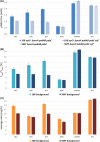Metabolic engineering of Bacillus subtilis for production of para-aminobenzoic acid - unexpected importance of carbon source is an advantage for space application
- PMID: 30980511
- PMCID: PMC6559200
- DOI: 10.1111/1751-7915.13403
Metabolic engineering of Bacillus subtilis for production of para-aminobenzoic acid - unexpected importance of carbon source is an advantage for space application
Abstract
High-strength polymers, such as aramid fibres, are important materials in space technology. To obtain these materials in remote locations, such as Mars, biological production is of interest. The aromatic polymer precursor para-aminobenzoic acid (pABA) can be derived from the shikimate pathway through metabolic engineering of Bacillus subtilis, an organism suited for space synthetic biology. Our engineering strategy included repair of the defective indole-3-glycerol phosphate synthase (trpC), knockout of one chorismate mutase isozyme (aroH) and overexpression of the aminodeoxychorismate synthase (pabAB) and aminodeoxychorismate lyase (pabC) from the bacteria Corynebacterium callunae and Xenorhabdus bovienii respectively. Further, a fusion-protein enzyme (pabABC) was created for channelling of the carbon flux. Using adaptive evolution, mutants of the production strain, able to metabolize xylose, were created, to explore and compare pABA production capacity from different carbon sources. Rather than the efficiency of the substrate or performance of the biochemical pathway, the product toxicity, which was strongly dependent on the pH, appeared to be the overall limiting factor. The highest titre achieved in shake flasks was 3.22 g l-1 with a carbon yield of 12.4% [C-mol/C-mol] from an amino sugar. This promises suitability of the system for in situ resource utilization (ISRU) in space biotechnology, where feedstocks that can be derived from cyanobacterial cell lysate play a role.
© 2019 The Authors. Microbial Biotechnology published by John Wiley & Sons Ltd and Society for Applied Microbiology.
Conflict of interest statement
The authors declare that they have no competing interests.
Figures





References
-
- Albertini, A.M. , and Galizzi, A. (1999) The sequence of the trp operon of Bacillus subtilis 168 (trpC2) revisited. Microbiology 145: 3319–3320. - PubMed
Publication types
MeSH terms
Substances
Supplementary concepts
LinkOut - more resources
Full Text Sources
Other Literature Sources
Miscellaneous

